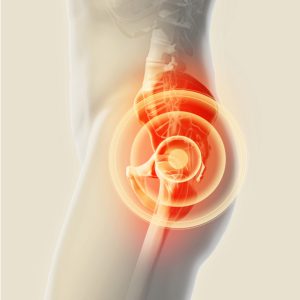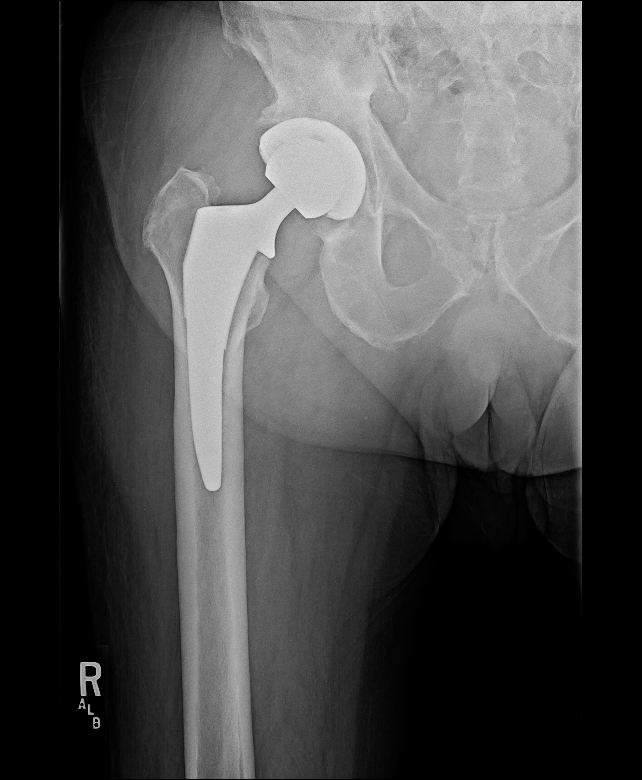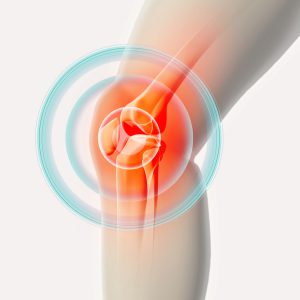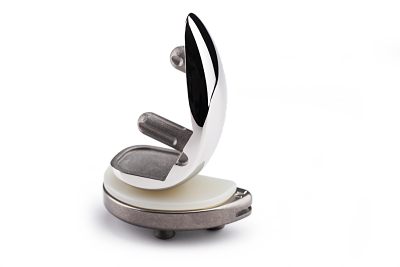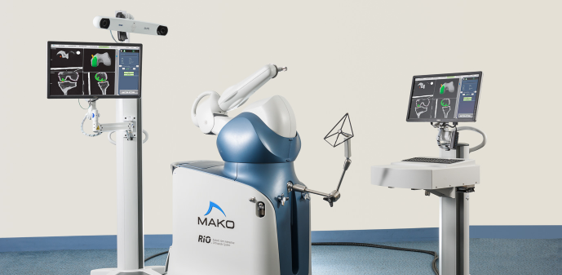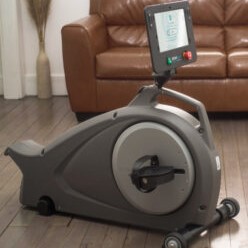Total hip arthroplasty is a procedure to remove the damaged hip joint and replace it with an artificial one with the goal of returning to the activities previously enjoyed without discomfort. Although the anterior approach to total hip replacement was first performed over 50 years ago in France, it wasn’t popularized until much more recently in the United States with the advent of a specialized table. This approach allows the surgeon to replace the damaged joint by working between the muscles rather than detaching them. It is performed through a small incision utilizing minimally invasive techniques on the front of your hip. The anterior approach allows for the use of xray during the surgery to ensure accurate component placement and leg lengths. Advantages of the anterior approach over the more traditional posterior approach include more accurate component placement, accelerated early recovery and pain relief, decreased dislocation rates, and no need for hip precautions following surgery.
Dr. Russo utilizes a controlled surgical impaction tool called “Kincise” rather than a mallet to deliver a precise amount of force when preparing the bone, decreasing risk of possible fracture and improved preservation of the cancellous bone. In addition, a computer navigation system called “Velys” is used in all patients during surgery to confirm accurate component positioning as well as leg length measurement from one side to the other.
Typically, patients who may be a candidate for a total hip replacement have significant groin pain that often can travel down the front of their thigh, sometimes all the way to the knee while performing everyday activities such as walking, hiking, or running. Often, patients will complain of difficulty placing their shoes or socks. Discomfort in the buttocks is usually referred pain from the low back and spine rather than the hip itself. If the discomfort is only mild, surgery would not be recommended as patients will often find that their pain is improved with anti-inflammatory medications, physical therapy, or steroid injections.
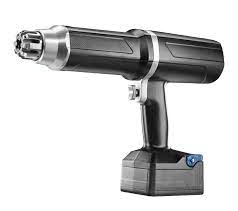

Total knee replacement is a procedure to remove the damaged knee joint and replace it with an artificial one composed of metal and plastic. As opposed to partial knee replacement, a total knee arthroplasty refers to the replacement of the entire joint. Total knee replacement is one of the most common and most successful procedures performed in orthopedic surgery, allowing patients to return to activities such as walking, golfing, and biking with a significant improvement in discomfort. The surgery is performed through an incision on the medial side of the knee, cutting away the damaged bone and replacing the joint by cementing metal components to the bone ends and placing a plastic component in between, allowing the joint to move freely without the grinding limitation and pain of arthritis.
Candidates for total knee replacement are typically 50+ years of age and will often describe a sharp pain in the knee associated with activity that is not relieved with over-the-counter anti-inflammatory medicines, physical therapy, or steroid injections.
Dr. Russo utilizes a special portable device after your knee replacement called “Portable Connect” which is delivered to your home after your surgery and is covered by your insurance. This device allows your new knee to complete a full revolution even if you only can comfortably achieve limited motion immediately after surgery through variable pedal radius technology. This allows for a more rapid progression of your range of motion. Dr. Russo can monitor your progress after surgery through this device remotely through a personalized portal to ensure you are achieving optimal results.
The “Russo Knee” approach to total knee replacement surgery has evolved over three generations. Vincent P. Russo, MD performed the original procedure in the 1970’s. Vincent J. Russo, MD modified the technique in the 1980’s to include a subvastus muscle-sparing approach to preserve the quadriceps from injury and enhance initial recovery. Matthew W. Russo, MD further built upon the tenets of this minimally invasive surgical technique passed down to him while also incorporating the latest technological advancements and principles of modern total knee replacement alignment strategies.
Although the muscle-sparing technique of subvastus knee replacement has been around for decades, recent media campaigns that compare your knee replacement to changing the oil in your car, suggest that this is a new concept. In reality, thousands of “Russo Knee” patients have benefited from a similar approach over the last five decades.
It is important to understand however, that successful total knee replacement in the long-term is about more than just a minimally invasive approach. Balance, alignment, and kinematics of how the components are placed in the knee have been studied extensively in the orthopedic literature and arguably may be more important to the long-term results of total knee replacement. Most recent data has shown that recreating the patient’s unique anatomy before the onset of deformity while also respecting the balance of three kinematic axes of rotation in the knee is the key to implant survival, reduced pain, and improved long-term stability, and functionality.
Unlike many traditional alignment techniques, Dr. Russo offers a personalized approach to total knee replacement often referred to as “kinematic alignment”. This technique combined with a subvastus muscle-sparing surgical exposure, medial oblique skin incision, and a home-delivered exercise stationary bicycle allows for greater patient satisfaction, earlier return to function, and improved long-term results following total knee replacement surgery.
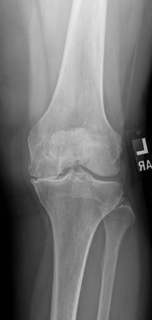


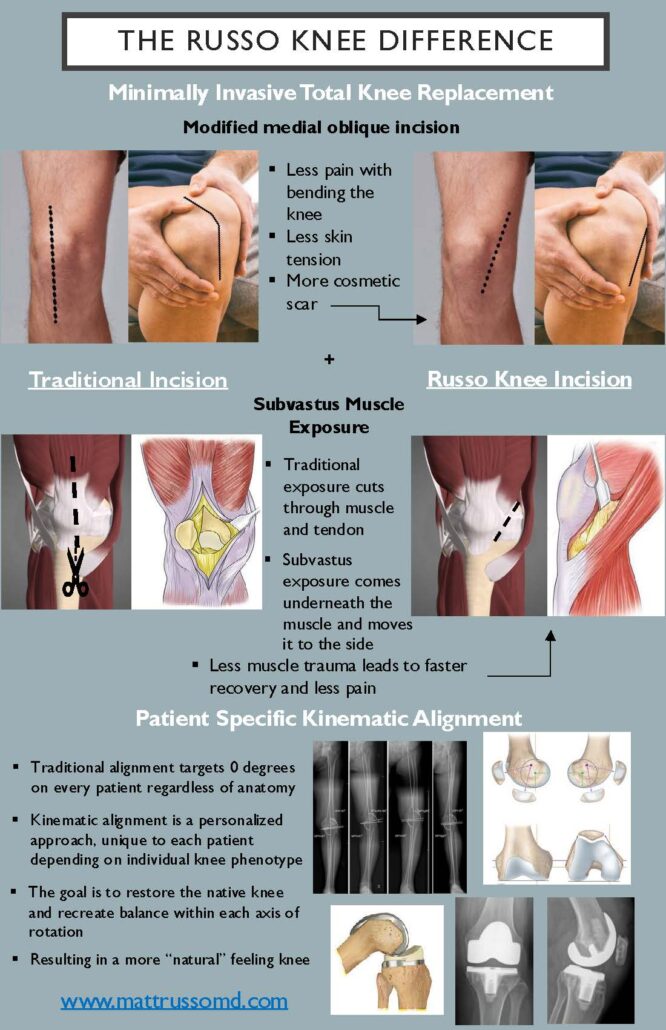
Minimally invasive partial knee replacement is an alternative to total knee replacement and involves only replacing the part of the knee that has been damaged. The knee has three compartments, the inside (medial), outside (lateral), and patellofemoral (under the knee cap). While oftentimes severe arthritis will involve the entire knee, if only one of the compartments is involved, then you may be a candidate for a partial knee replacement. Advantages of partial knee replacement include enhanced recovery with the procedure typically performed on an outpatient basis and a more natural feeling knee due to the preservation of all your native ligaments. Partial knee replacement patients continue to enjoy an active lifestyle, returning to many activities that are often avoided after total knee surgery.
Candidates for partial knee replacement will often describe isolated pain only in one specific part of the knee, most commonly on the inside (medial) aspect, associated with activities such as walking, jogging, golfing, or recreational sport. Similar to other forms of joint replacement however, if the discomfort is only mild then surgery would not be recommended as patients will often find that their pain is improved with anti-inflammatory medications, physical therapy, or steroid injections.
Although joint replacement continues to be one of the most successful surgeries performed in this country, there are occasional complications that may require revision surgery. The causes for revision surgery are numerous and require a discussion with your surgeon to discuss your individual options if you are the recipient of a total joint replacement but continue to have activity-limiting pain or discomfort.
Complex joint replacement may be necessary for the patient who requires a total joint surgery but has complex anatomy, prior injury, or repeated prior surgery that complicates how the surgery is performed. These patients may require a surgeon with experience in many different aspects of joint replacement surgery to ensure the best outcome possible.
Dr. Russo utilizes a special portable device after your knee replacement called “Portable Connect” which is delivered to your home after your surgery and is covered by your insurance. This device allows your new knee to complete a full revolution even if you only can comfortably achieve limited motion immediately after surgery through variable pedal radius technology. This allows for a more rapid progression of your range of motion. Dr. Russo is able to monitor your progress after surgery through this device remotely through a personalized portal to ensure you are achieving optimal results.

